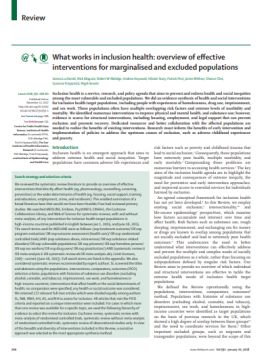What works in inclusion health: Overview of effective interventions for marginalised and excluded populations
In this article, the authors introduce the concept of “inclusion health,” defining it as “an emergent approach that aims to address extreme health and social inequities” [1, p. 266]. The goal of this strategy, they explain, is to draw attention to inequities experienced by individuals and groups who experience harm by being excluded from society.
In the absence of an agreed upon framework for inclusion, this article describes the application of an inclusion health approach to health system interventions for early intervention, improved access to services and reducing health inequities.
Components of an inclusion health approach
The article identifies and describes key components of an inclusion health approach, including psychosocial, pharmacological, case management and disease prevention interventions. It also outlines approaches related to housing and social determinants, as well as those tailored to women and young people, highlighting the need to attend to specific needs of those groups most excluded.
Central to the inclusion health approach is the need to involve those who live with inequities, who will put interventions and approaches into context of the lived experience of exclusion. The authors describe implications for service planning and policy development, offering recommendations for public health and primary care practice, research, intervention design and policy development. In particular, they note that addressing the root causes of exclusion due to structural disadvantages of living in recurrent material deprivation and poverty is central to an effective policy response.
Use this resource to:
- discuss the concept of inclusion health with colleagues as part of a continuing education or professional development activity;
- sketch a profile of groups and communities that experience exclusion in your area, as well as the social determinants for which they experience the most disadvantage; and
- develop and propose an inclusion health lens for interventions to address health inequities.
Related resources
Webinar recording: Participatory practice and health promotion in Canada (2018)
Webinar recording: Informing public health programs through engagement with communities that live with health inequities (2019)
Webinar recording: Health and proximity to local resources (2019)
Overcoming poverty together: The New Brunswick economic and social inclusion plan 2014-19 (2014)
Place standard: How good is our place? (2015)
Reference
Luchenski, S., Maguire, N., Aldridge, R.W., Hayward, A., Story, A., Perri, P., Withers, J., Clint, S., Fitzpatrick, S., Hewett, N. (2018). What works in inclusion health: Overview of effective interventions for marginalised and excluded populations. The Lancet;391(10117):266-280.
References
[1] Luchenski, S., Maguire, N., Aldridge, R.W., Hayward, A., Story, A., Perri, P., Withers, J., Clint, S., Fitzpatrick, S., Hewett, N. (2018). What works in inclusion health: Overview of effective interventions for marginalised and excluded populations. The Lancet;391(10117):266-280.
Tags: Community engagement, Socioeconomic status, Stigma, discrimination, Journal Article
